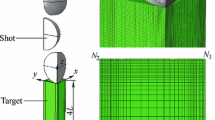Abstract
Finite element (FE) simulations are commonly used to investigate shot peening effects by implementing the impact process of multiple shots upon a target which with small geometry size. The target is selected with small size from the practical large component to economize the computational resources in simulation. Under this condition, the lumped mass of each shot in FE simulation should be designed according to its impact position on the target to balance the influence of boundary constraints. Aiming to obtain the same indenting depth of a shot impacting at any position, the evolutions of indenting depth and related energies are studied. An approach is proposed based on the strains and stresses of an impact on semi-infinite body to design the lumped mass of shot on various shape targets. With the proposed approach, a random peening process involving 300 impacts is simulated to detect the size evolution of dimples, which is useful for determining peening coverage precisely. The random peening simulation presents a decrease of average dimple size with impact density. And regular multiple-impact simulations present the same trend, indicating the capability of multiple-impact analyses on the prediction of dimple size evolution. The simulation results are verified by shot peening experiments.
Similar content being viewed by others
References
Seddik R, Bahloul A, Atig A, Fathallah R (2017) A simple methodology to optimize shot-peening process parameters using finite element simulations. Int J Adv Manuf Technol 90:2345–2361
Zhang J, Lu S, Zhang T, Xu G, Zhou Z (2018) An analytical model to study of potential effects on component elongation in shot peening. Int J Adv Manuf Technol 97:3299–3310
Miao H, Larose S, Perron C, Lévesque M (2009) On the potential applications of a 3d random finite element model for the simulation of shot peening. Adv Eng Softw 40:1023–1038
Bagherifard S, Ghelichi R, Guagliano M (2012) On the shot peening surface coverage and its assessment by means of finite element simulation: a critical review and some original developments. Appl Surf Sci 259:186–194
Zhang J, Lu S, Wu T, Zhou Z, Zhang W (2018) An evaluation on sp surface property by means of combined fem-dem shot dynamics simulation. Adv Eng Softw 115:283–296
Klemenz M, Schulze V, Rohr I, Löhe D. (2009) Application of the fem for the prediction of the surface layer characteristics after shot peening. J Mater Process Technol 209:4093–4102
Guagliano M (2001) Relating almen intensity to residual stresses induced by shot peening: a numerical approach. J Mater Process Technol 110:277–286
Kim T, Lee H, Jung S, Lee JH (2012) A 3D FE model with plastic shot for evaluation of equi-biaxial peening residual stress due to multi-impacts. Surface Coatings Technol 206:3125–3136
Kim T, Lee H, Hyun HC, Jung S (2013) Effects of rayleigh damping, friction and rate-dependency on 3D residual stress simulation of angled shot peening. Mater Des 46:26–37
Gariépy A, Miao H, Lévesque M (2017) Simulation of the shot peening process with variable shot diameters and impacting velocities. Adv Eng Softw 114:121–133
Miao H, Larose S, Perron C, Lévesque M (2011) Numerical simulation of the stress peen forming process and experimental validation. Adv Eng Softw 42:963–975
Hu D, Gao Y, Meng F, Song J, Wang Y, Ren M, Wang R (2017) A unifying approach in simulating the shot peening process using a 3D random representative volume finite element model. Chin J Aeronaut 30:1592–1602
Kirk D, Abyaneh MY (1995) Theoretical basis of shot peening coverage control. Shot Peener(USA) 9:28–30
Karuppanan S, Romero J, de los Rios E, Rodopoulos C, Lever A (2002) A theoretical and experimental investigation into the development of coverage in shot peening. In: Proceedings of the 8th international conference on shot peening, pp 101–107
Johnson G, Cook W (1983) A constitutive model and data for metals subjected to large strains, high strain rates and high temperatures. In: Proceedings of the seventh international symposium on ballistics, pp 541–547
Lesuer D (2000) Experimental investigation of material models for Ti-6Al-4V and 2024-T3, Technical Report FAA Report DOT/FAA/AR-00/25
Acknowledgements
The authors would like to acknowledge the support for this research work from National Natural Science Foundation of China (Grant No. 51805432), China Postdoctoral Science Foundation (Grant No. 2018M633541), Natural Science Basic Research Plan in Shaanxi Province of China (Grant No. 2018JQ5084), and Natural Science Foundation of Shaanxi Provincial Department of Education (Grant No. 18JK0571).
Author information
Authors and Affiliations
Corresponding author
Additional information
Publisher’s note
Springer Nature remains neutral with regard to jurisdictional claims in published maps and institutional affiliations.
Rights and permissions
About this article
Cite this article
Xiao, X., Sun, Y., Zhao, R. et al. A design for lumped mass of a shot model in random peening simulation and prediction of dimple size evolution. Int J Adv Manuf Technol 103, 4597–4608 (2019). https://doi.org/10.1007/s00170-019-03581-w
Received:
Accepted:
Published:
Issue Date:
DOI: https://doi.org/10.1007/s00170-019-03581-w




